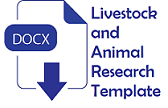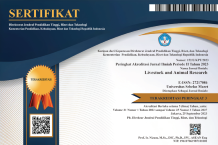Reducing the number of microorganisms and organic carbon by implementation of APS (Advanced Ponds System) in the wastewater of dairy goat with added liquid probiotics
Abstract
Objective: The activities of the dairy goat group, in general, have not paid attention to the processing of livestock waste that comes from maintenance activities. For example, liquid waste from cleaning cages and livestock baths, dirt, urine, and milking activities. Dairy goat farm waste, if not appropriately managed can have a negative impact on the quality of underground water sources, surface water, and the surrounding environment. Application of the Advanced Ponds System (APS) system with at part of Algae Settling Ponds pool size of 3 m x 1.5 m x 1.5 m with a dose of 50 ml / m3 of probiotic liquid so that 337.5 ml was needed. This study aimed to improve the wastewater based on microbiological and psycochemical characteristics by treatment of advanced pond system with probiotic in dairy goat farm.
Methods: The variables observed were the content of microorganisms (Escherichia coli and Salmonella sp.) and physicochemical characteristics (Total N, Organic matter, temperature, pH, organic carbon, C/N ratio) of dairy goat farm wastewater in the APS system at part of Algae Settling Ponds. Data were analyzed by independent samples t-test analysis.
Results: The results showed that the addition of liquid probiotic had no significant effect on temperature, pH, and C / N ratio, but affected organic carbon, E. coli and Salmonella sp. (P<0.05).
Conclusions: Based on the research results, it can be concluded the addition of liquid probiotic through the application of the Advanced Ponds System with at part of Algae Settling Ponds can be used as a solution to accelerate the improvement of the quality of dairy goat farm wastewater.Keywords
Full Text:
PDFReferences
Nik Daud, N. N., and C. S. Anijiofor. 2017. Livestock wastewater generation and farm management: the gap analysis. Acta Hortic. 1152: 265-272. Doi: https://doi. org/10.17660/ActaHortic.2017.1152.36.
Harrington, R., and R. McInnes. 2009. Integrated Constructed Wetlands (ICW) for livestock wastewater management. Biores. Tech. 100: 5498–5505. https://doi. org/10.1016/j.biortech.2009.06.007.
Corley, C. E. 2011. Principles of design and operations of wastewater treatment pond systems for plant operators, engineers, and managers. EPA, Illinois. p. 1–457.
Mambo, P. M., D. K. Westensee, B. M. Zuma, and A. K. Cowan. 2014. The Belmont valley integrated algae pond system in retrospect. Water SA 40: 385–93. Doi: https://doi.org/10.4314/wsa.v40i2.21.
Said, N. I. 2006. Daur ulang air limbah (water recycle) ditinjau dari aspek teknologi, lingkungan dan ekonomi. J. Air Indonesia 2: 100-131. Doi: https:// doi.org/10.29122/jai.v2i2.2300.
Loganayagi, C., and A. Ramesh. 2014. Mobility of sulfosulfuron and its metabolite aminopyrimidine in soil under laboratory conditions. Res. Rev. J. Ecol. Environ. 2: 47–54.
Lemunier, M., C. Francou, S. Rousseaux, S. Houot, P. Dantigny, P. Piveteau, and J. Guzzo. 2005. Long-term survival of pathogenic and sanitation indicator bacteria in experimental biowaste composts. App. Environ. Microbiol. 71(10): 5779–86. Doi: https://doi.org/10.1128/AEM .71.10.5779-5786.2005.
Sobsey, M. D., L. A. Khatib, V. R. Hill, E. Alocilja, and S. Pillai. 2006. Pathogens in animal wastes and the impact of waste management practices on the survival, transport and fate. In: J. M. Rice, D. F. Caldwell, F. J. Humenik, Animal Agriculture and the Environment: National Center for Manure and Animal Waste Management White Papers, eds. 2006. ASABE Pub, St. Joseph, Michigan. p. 609-666
García, R., J. Bælum, L. Fredslund, P. Santorum, and C. S. Jacobsen. 2010. Influence of temperature and predation on survival of Salmonella Enterica Serovar Typhimurium and expression of Inva in soil and manure-amended soil. App. Environ. Microbiol. 76: 5025–31. Doi: https://doi.org/10.1128/AEM.00628-10.
Nicholson, F. A., S. J. Groves, and B. J. Chambers. 2005. Pathogen survival during livestock manure storage and following land application. Biores. Techn. 96: 135–43. Doi: https://doi.org/10.1016/j.biortech.2004 .02.030.
Putra, A. H., and A. U. Farahdiba. 2018. Performance of algae reactor for nutrient and organic compound removal. Proc. ICST. p. 119-125. Doi: https://dx.doi. org/10.2991/icst-18.2018.26.
Unc, A., and M. J. Goss. 2006. Culturable in soil mixed with two types of manure. Soil Science Soc. Amer. J. 70: 763.Doi: https://doi.org/10.2136/sssaj2004.0367.
Tyagi, V. K., and A. K. Chopra. 2006. Alternative microbial indicators of faecal pollution: Current perspective. Iranian J. Environ. Health Sci. Eng. 3: 205–16.
Penakalapati, G., J. Swarthout, M. J. Delahoy, L. McAliley, B. Wodnik, K. Levy, and M. C. Freeman. 2017. Exposure to animal feces and human health: a systematic review and proposed research priorities. Environ. Sci. Tech. 51: 11537–11552. Doi: https://doi.org/10.1021/acs.est. 7b02811
Mahapatra D. M., H. N. Chanakya, T. V. Ramachandra. 2014. Bioremediation and lipid synthesis through mixotrophic algal consortia in municipal wastewater. Biores. Tech. 168: 142-150. Doi: 10.1016/ j.biortech.2014.03.130.
Sivakumar, G., J. Xu, R. W. Thompson, Y. Yang, P. Randol-Smith, and P. J. Weathers. 2012. Integrated green algal technology for bioremediation and biofuel. Bioresource Technol. 107: 1-9. Doi: https://doi. org/10.1016/j.biortech.2011.12.091.
Dieckow, J., J. Mielniczuk, H. Knicker, C. Bayer, D. P. Dick, and I. Kögel-Knabner. 2007. Comparison of carbon and nitrogen determination methods for samples of a Paleudult subjected to no-till cropping systems. Scientia Agricola 64: 532-540. Doi: https://doi.org/10.1590/S0103-90162007000 500011.
Sutton, S. 2010. The most probable number method and its uses in enumeration, qualification, and validation. J. Validation Technol. 16: 35–38. Doi: https://doi.org/ 10.1097/RLI.0b013e318234e75b.
Yuliani, N. S., E. Wera, dan P. M. Bulu. 2009. Identifikasi bakteri salmonella sp dan jumlah total kontaminan bakteri coliform pada ikan kembung (Scomber sp.) yang dijual di pasar inpres dan oeba. Jurnal PARTNER. 16: 16-20. Doi: http://dx.doi. org/10.35726/jp.v16i1.49
Maragkoudakis P. A., G. Zoumpopoulou, C. Miaris, G. Kalantzopoulos, B. Pot, and T. Tsakalidou. 2006. Probiotic potential of lactobacillus strains isolated from dairy products. Int. Dairy J. 16: 189- 199. Doi: https://doi.org/10.1016/j.idairyj.2005. 02.009.
Charlier C., S. Even, M. Gautier, and Y. le Loir. 2008. Acidification is not involved in the early inhibition of Staphylococcus aureus growth by Lactococcus lactis in milk. Int. Dairy J. 18:197-203. Doi: 10.1016/j.idairyj .2007.03.015
Michitsch, R., R. Gordon, R. Jamieson, and G. Stratton. 2017. Bacterial pathogen occurrence and persistence in livestock mortality biopiles. Resources 6(4): 49. https://doi.org/10.3390/resources6040049.
Wilkinson, K. G. 2007. The biosecurity of on-farm mortality composting. J. App. Microbiol. 102: 609–18. Doi: https:// doi.org/10.1111/j.1365-2672.2006.03274.x.
Widowati, L. R., R. Saraswati, and S. Rochayati. 2011. Nitrogen Cycling and Composting Technologies in Livestock Manure Management. In: Kementerian Pertanian, Data Inventory and Mitigation on Carbon Emission and Nitrogen Cycling from Livestock in Indonesia. Badan Penelitian dan Pengembangan Pertanian. IAARD Press, Jakarta. p. 78-109.
Queiroz, L. M., M. V. Aun, D. M. Morita, and P. A. Sobrinho. 2011. Biological nitrogen removal over nitrification/ denitritation using phenol as carbon sources. Brazil J. Chem. Eng. 28: 197-207. Doi: http://dx.doi.org/10.1590/S0104-6632 2011000200004.
Adekunle, K. F., and J. A. Okolie. 2015. A review of biochemical process of anaerobic digestion. Adv. Biosci. Biotech. 6: 205–212. Doi: http://dx.doi.org/10.4236/abb.2015.63 020.
Sondang, Y., K. Anty, and R. Alfina. 2014. The influence of bioactivator cattle feces against the length of composting and C/N ratio from three kind of organic material. Int. J. Adv. Sci. Eng. Inf. Tech. 4: 74–77. Doi: https://doi.org/10.18517/ijaseit.4.4.416.
Prayitno, and M. Sholeh. 2014. Pengurangan nitrogen pada limbah cair terolah industri penyamakan kulit menggunakan sistem wetland buatan. Majalah Kulit, Karet, dan Plastik 30: 79-86. Doi: http://dx.doi.org/10.20543/mkkp.v30i 2.129.
Ogunsesin, A., and E. A. Aiyelari. 2017. Effect of swine manure with terminalia Catappa leaves compost and NPK fertilizer on growth and yield of Pepper (Capsicum chinense Jacq.) in Ibadan, Nigeria. Int. J. Sci. Res. Pub. 7: 417–426.
Refbacks
- There are currently no refbacks.










